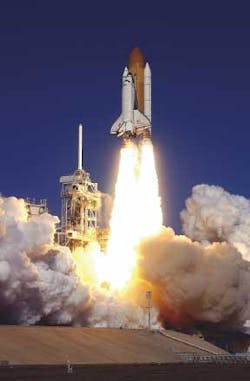DOD, NASA budgets projected to rise; defense spending to exceed half trillion
By John Rhea
WASHINGTON — Substantial increases in funding for the U.S. Department of Defense (DOD) and NASA are envisioned in the budget documents submitted to Congress in February.
DOD budget authority is due to grow from $364.5 billion in the current fiscal year to $379.9 billion in fiscal year 2004, which begins Oct. 1. The NASA budget for the same period would increase by $470 million to $15.5 billion. Thus the total NASA budget for the coming year will be comparable to this year's increase for the defense budget.
Moreover, as part of the Future Year Defense Plan, Pentagon leaders are projecting steady growth to $483.6 billion in 2009. With military money in the Department of Energy (essentially work on nuclear weapons) and other federal agencies, total national defense spending is projected to exceed half a trillion dollars by 2009, or $502.7 billion.
Of the budget sectors of particular interest to industry, procurement is expected to rise steadily from $70 billion this year to $72.7 billion in the coming year and then on to $112.2 billion in 2009. Over the same period, research, development, test, and evaluation (RDT&E) is to rise more modestly from $56.8 billion to $61.8 billion and then to $69.4 billion five years later. The projection for operations and maintenance (O&M) is from $113.6 billion to $117 billion to $139.7 billion.
These numbers do not include the costs of military action against Iraq. As a standard for comparison, the total cost of the 1991 Persian Gulf War was $61 billion, and $50 billion of that came from Japan, Saudi Arabia, and other countries. The numbers also do not include activities in Afghanistan, which DOD officials say, "was no longer a hot war."
The NASA budget, prepared before the tragedy of the Space Shuttle Columbia, rose a modest 3.8 percent, but Congress is expected to increase funding for safety improvements in human space flight.
null
The heart of the defense budget for the electronics industry is the category known as command, control, communications, computers, intelligence, surveillance, and reconnaissance (C4ISR) Officials at the news briefing stressed that this is also the heart of the administration's program to transform the military establishment — specifically by increasing communications bandwidth.
Three space-related programs will go under the C4ISR umbrella in 2004: laser satellite communications, which the officials say "breaks the back of the bandwidth problem," at $452 million; an advanced extremely high frequency (EHF) satellite at $778 million; and space-based radar at $299 million.
Also in the C4ISR category are unmanned vehicles, including aerial vehicles to deliver ordinance and undersea vehicles, at $1.4 billion; the Joint Tactical Radio program at $478 million; and modernization of cryptographic equipment at $416 million.
The defense officials conceded that the coming year's RDT&E request would still fall short of the goal of spending 3 percent of the total DOD budget on science and technology. This remains a "right objective," they said, and they expect to achieve it by 2008 or 2009.
Despite the increases, however, the defense officials claimed that DOD spending as a percentage of the nation's gross domestic product (GDP) would fall to 3.4 percent in the coming year. It was once as high as 8.9 percent of GDP during the late 1960s due to Cold War and Vietnam expenditures. And as a percentage of the total federal budget, DOD outlays have dropped from 43.4 percent to 16.6 percent over the same period, according to the officials.
The NASA budget request envisions a more modest rise, according to an analysis by the American Institute of Physics (AIP) in College Park, Md. The 2004 budget is 3.1 percent greater than the Bush Administration requested for 2003 and 3.8 percent more than NASA received in 2002. The budget was prepared before the tragedy of the space shuttle Columbia, however, and congressional leaders say they would push to include extra money for safety improvements. This is a bipartisan effort that includes Sens. Bill Nelson, D-Fla., and Ted Stevens, R-Alaska.
The big-ticket items at NASA continue to be the Space Shuttle ($3.968 billion in the coming year) and the International Space Station ($1.707 billion). Space station funding was due to decline in the out years as the program approaches completion, but the Columbia tragedy may change this plan.
Significant increases are projected for space science. The 2004 request of $4 billion is up 39.8 percent from the 2002 budget and 15 percent from the 2003 request, according to the AIP. Major items in this category are Solar System exploration at $1.359 billion and Mars exploration at $570 million. The latter program envisions unmanned missions in 2005, 2007, and 2009.

